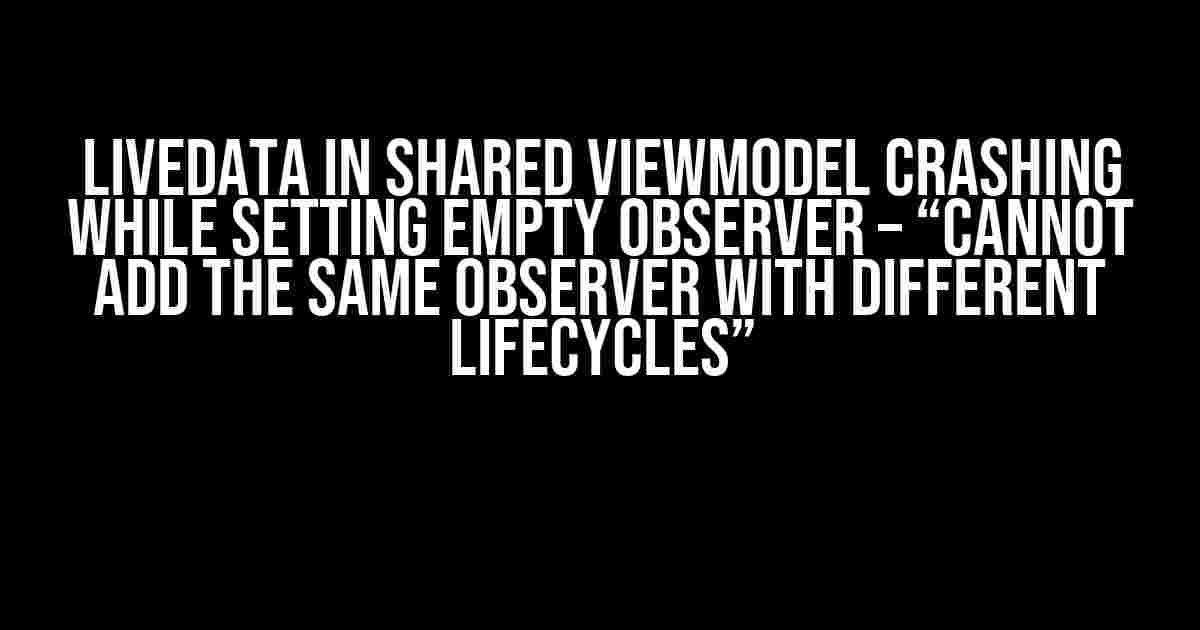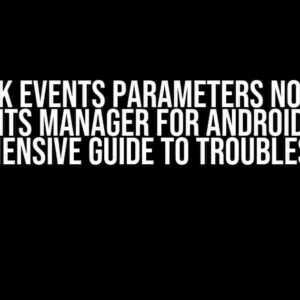When working with Android Architecture Components, specifically with LiveData and ViewModel, developers may encounter an error while setting an empty observer. This error throws the exception “Cannot add the same observer with different lifecycles”. In this article, we will explore the causes and solutions to this issue.
The Problem
LiveData is a data holder class that can be observed within a given lifecycle. When you observe LiveData, you need to specify the lifecycle that will trigger the observer. The problem arises when you try to set an empty observer on LiveData in a shared ViewModel.
Error Message
The error message “Cannot add the same observer with different lifecycles” is thrown because LiveData does not allow adding the same observer with different lifecycles. This is a safety mechanism to prevent unexpected behavior.
Cause of the Error
The main cause of this error is that multiple fragments or activities are trying to observe the same LiveData with different lifecycles. This can happen when you have a shared ViewModel that is used across multiple fragments or activities, and each of them tries to observe the LiveData.
Example Scenario
Imagine you have a shared ViewModel that is used by two fragments, FragmentA and FragmentB. Both fragments observe the same LiveData in the ViewModel. When FragmentA observes the LiveData, it sets the lifecycle of FragmentA as the observer’s lifecycle. Later, when FragmentB tries to observe the same LiveData, it sets the lifecycle of FragmentB as the observer’s lifecycle. This results in the “Cannot add the same observer with different lifecycles” error.
Solution
To solve this issue, you can use a MediatorLiveData that merges the LiveData from the shared ViewModel with a new LiveData that has a unique lifecycle. Here’s an example:
MediatorLiveData<LiveData<Data>> liveDataMerger = new MediatorLiveData<>();
liveDataMerger.addSource(viewModel.getLiveData(), data -> liveDataMerger.setValue(data));
return liveDataMerger;
In this example, MediatorLiveData acts as an intermediary between the LiveData from the shared ViewModel and the new LiveData that will be observed by the fragment or activity. By doing so, each fragment or activity can observe the LiveData with its own unique lifecycle, avoiding the “Cannot add the same observer with different lifecycles” error.
Conclusion
In conclusion, the “Cannot add the same observer with different lifecycles” error is a common issue that can occur when using LiveData and ViewModel in Android development. By understanding the cause of the error and using MediatorLiveData to merge the LiveData with a unique lifecycle, you can resolve this issue and ensure that your app works as expected.
Frequently Asked Question
Get solutions to the most common conundrums about LiveData in shared ViewModel crashing while setting empty observer!
Why does LiveData in shared ViewModel crash while setting an empty observer?
The crash occurs because you’re trying to add the same observer with different lifecycles to the LiveData. This is not allowed, as each observer must have a unique lifecycle. To fix this, ensure that you’re not adding the same observer multiple times, and that each observer has a distinct lifecycle.
How can I check if an observer is already added to LiveData?
Unfortunately, there’s no built-in method to check if an observer is already added to LiveData. However, you can maintain a flag or a boolean variable to track whether the observer has been added or not. Alternatively, you can remove the observer before adding it again to avoid duplication.
Can I use a single instance of ViewModel across multiple fragments?
Yes, you can share a ViewModel instance across multiple fragments, but be cautious when doing so. Make sure to handle the lifecycle of the ViewModel correctly, and be aware of the potential issues that may arise from sharing a single instance.
How can I ensure that my LiveData observer is removed when the fragment is destroyed?
To remove the LiveData observer when the fragment is destroyed, use the `onDestroyView()` method to remove the observer. This ensures that the observer is detached from the LiveData when the fragment is no longer visible.
Are there any best practices for using LiveData with a shared ViewModel?
Yes, follow these best practices: use a single instance of the ViewModel, handle the lifecycle of the ViewModel correctly, and be mindful of the potential issues that may arise from sharing a single instance. Additionally, use Android’s built-in mechanisms, such as the `ViewModelProvider`, to manage the ViewModel instance.


